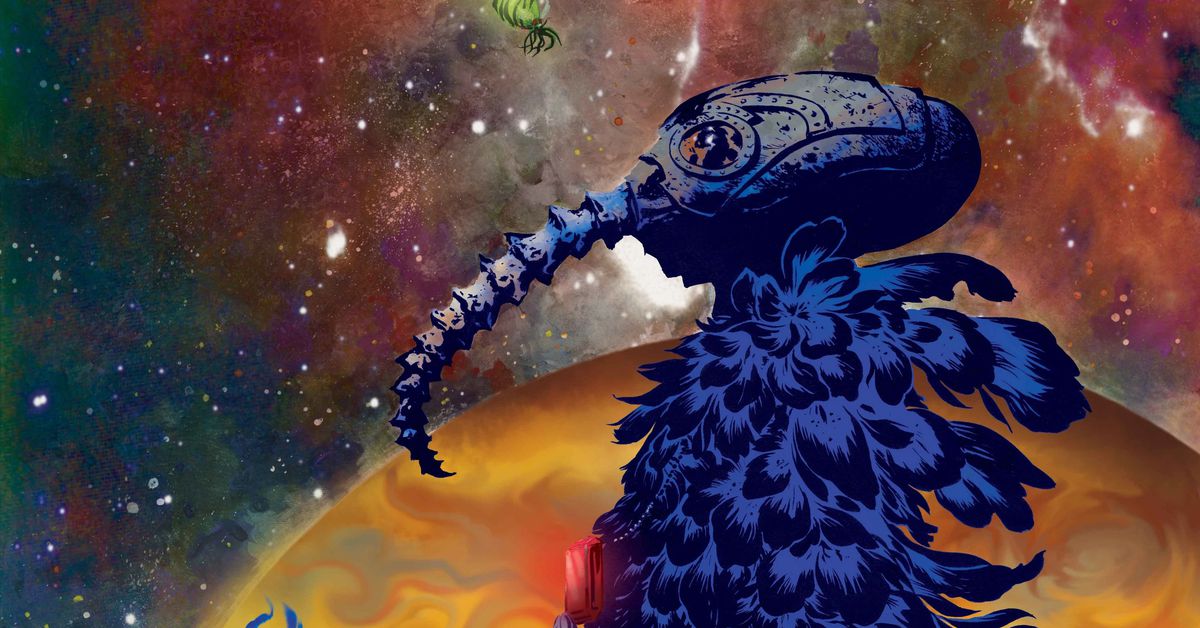Neil Gaiman’s The Sandman is a many-splendored wonder. One part pulp horror, one part urban fantasy comic replete with Shakespearean and mythological cameos, the comic covers a lot of ground with a host of characters both mundane and otherworldly. What begins as a story about Morpheus, the immortal King of Dreams, and his quest for redemption gradually evolves into something even larger: a story about the nature of stories themselves and their essential relationship to humanity.
The original 75-issue series, along with its assorted constellation of spinoff series and books, is a multifarious anthology of beautifully illustrated and brilliantly told stories that run the gamut from bone-chilling to soul-stirring.
In celebration of the long-awaited live-action TV adaptation of The Sandman, which premiered this weekend on Netflix, we’ve put together a list of some of our favorite volumes and issues from the comic for those looking to explore the universe of the original series in more detail. Sweet dreams, and happy reading.
24 Hours (Issue #6)
:no_upscale()/cdn.vox-cdn.com/uploads/chorus_asset/file/23921470/Screen_Shot_2022_08_03_at_3.17.16_PM.png)
Image: Neil Gaiman, Mike Dringenberg/DC Comics
The Sandman started its life as a horror comic before it become something much more. “24 Hours” is the horror version of Sandman at the height of its powers: mean, haunting, and skin-crawlingly upsetting, a one-act play where diner patrons slowly go mad together.
The story is mostly stand-alone: John Dee, a D-List DC Comics villain, has obtained Dream’s ruby, which contains much of his powers to realize the dreams of others. Already a twisted soul, Dee is further corrupted by the ruby, which warps his body into its current ghoulish appearance. Recently freed from imprisonment, Dee slinks into a diner and makes its patrons his first victims — using the ruby’s powers to manipulate their desires and warp them into monsters, or subdue them into servitude and adulation.
From the very start, Sandman makes it clear that dreams and nightmares come hand in hand, and one cannot exist without the other. “24 Hours” applies that rule to the sort of dreams we have when awake: secret ambitions, desires, and fame. They are the stuff we build our lives on, but they also our undoing — and the most frightening thing about them is that we don’t need the cruel supernatural push of John Dee to be consumed by them. —Joshua Rivera
The Sound of Her Wings (Issue #8)
Image: Neil Gaiman, Mike Dringenberg/DC Comics
No other issue of The Sandman stands out as more definitive in my mind than issue 8, “The Sound of Her Wings.” This has very little to do with the particulars of the story itself, which alone registers as a more or less minor aside in the larger story of Dream’s return to power after a century of imprisonment. “The Sound of Her Wings” is significant because it marks the point in which the then-fledgling fantasy comic finally found its own voice, or rather, the moment when Neil Gaiman stopped trying so hard to write a DC Comics story and instead allowed himself to fully write a Neil Gaiman story. Take it from Gaiman himself, who said in a recent interview, “I’m incredibly fond still of ‘The Sound of Her Wings,’ the first meeting of Death, because that is the first time I felt like I sounded like me.”
The issue follows Dream who, listless in the wake of his mission to recover his lost symbols of office, follows his sister — the anthropomorphic personification of death — as she performs her duty of ushering the recently deceased into the “sunless lands” of the afterlife. It’s a medley of tones, at once whimsical and melancholic, macabre and life-affirming, heartrending and achingly poignant. “The Sound of Her Wings” is a the story of an immortal being gaining perspective through an up-close observation of humanity and a reaffirmed grasp of the value and meaning of both life and death. —Toussaint Egan
Men of Good Fortune (Issue #13)
Image: Neil Gaiman, Michael Zulli/DC Comics
“Men of Good Fortune” has one of my favorite premises for what’s essentially a pretty basic short story: In 1389, Robert “Hob” Gadling, a loud, brash tavern patron, is boasting to all who will hear about his latest idea. Death, he says, is “a mug’s game,” something that people only do because everyone else does it, and they’re all suckers for it. But Hob Gadling, he’s no sucker like the rest of us. He’s just not going to die.
Unbeknownst to him, Death and her brother Dream are in the tavern as well, and they decide it would be amusing to see Hob stick to his word. So Dream sits down and calls Hob on his bluster, saying if Hob intends to not die, he’ll have to tell Dream about it, and meet him at the same pub in 100 years. So that’s what they do, for centuries.
Brought to life by Michael Zulli, whose rich pencils would reappear throughout The Sandman’s run, “Men of Good Fortune” does something The Sandman’s stand-alone short stories were uniquely good at: taking the cosmic everlasting scale of the Endless and using it to make smaller stories resonate that much more. For all of his power and wonder, Dream’s story is only compelling for the ways it intersects with ours, even if all he does is walk into a bar and exit with a friend. —JR
Seasons of Mists (Vol. 4)
Image: Neil Gaiman, Kelley Jones/DC Comics
Spoiler alert for a likely upcoming season of The Sandman: Casting Gwendoline Christie as Lucifer is a pretty sure sign that the creative team is hoping to do more with the character. And that would mean getting into the stellar Season of Mists storyline, where Lucifer kicks everyone out of hell, demons and souls of the damned alike, then locks it up tight and hands Dream the key. It’s a particularly sophisticated revenge scheme, aimed straight at Dream’s unbudging sense of duty: He can’t walk away from the responsibility of owning hell, but as it turns out, it’s a valuable piece of unreal estate, and everyone from defunct godly pantheons to the forces of Chaos wants it, and wants to bribe or blackmail or murder him to get it.
The way Dream navigates the situation over the Season of Mists collection tells us a lot more than we knew previously about who he is and how he handles his responsibilities and his realm. But the real pleasure of the arc is learning so much more about the Sandman cosmos — about the key players, how they work and what they want, and what intrigue between heaven, hell, and the courts of Faerie looks like. —Tasha Robinson
Brief Lives (Vol. 7)
Image: Neil Gaiman, Jill Thompson/DC Comics
There are very, very few duds in the 10 volumes that make up the complete Sandman, and each of them is slightly different. But none of them combines the best of all aspects of the comic as vol. 7, Brief Lives. There’s Endless family drama. The Waking World. Old gods in modern settings. Amusing and disturbing interactions between mortals and immortals. A talking severed head and a sarcastic dog.
Best of all, it’s a road trip story about two estranged siblings looking for a third, and the siblings are simultaneously nigh-omnipotent beings beyond the ken of man and don’t know how to drive a car. —Susana Polo
An Epilogue, Sunday Mourning (Issue #73)
Image: Neil Gaiman, Michael Zulli/DC Comics
The best character in The Sandman is Hob Gadling, the Englishman from the 1300s who swore he would never die and then didn’t. Both of his feature issues are great in their own way. But there is a special place in my heart for the final issue in which he appears, where this guy who was born in actual medieval times goes to a Renaissance faire and is grumpy and homesick about every single thing he sees. Of course there’s an emotional core to the story about Hob’s unflagging zest for life and his own grief at outliving everyone he’s ever loved — but also, every time I go to a Renaissance faire, I have Hob Gadling in my head, complaining that the beer is served cold, nothing is covered in shit, and there’s no one walking around with untreated face tumors. —SP
The Sandman: Overture (Limited Series)
Image: Neil Gaiman, J.H. Williams III/Vertigo
While the six-issue limited series The Sandman: Overture serves as an immediate prologue to the first issue of Sandman, it’s best read as an epilogue to the 10-volume series. Overture details the story of the “great battle” that left Dream in the weakened state we find him in “Sleep of the Just,” chronicling his journey to a distant galaxy to investigate the murder of one of his aspects by a renegade star whose madness has metastasized into a “dream vortex” that threatens all of existence.
It’s a sweeping odyssey across a vast cosmos teeming with primordial oddities and strange allies, rendered through the impeccable visual storytelling of J.H. Williams III (Batwoman, Promethea), whose grandiose widespread panels and layouts evoke the sum total of the original series’ artistic ambitions in breathtaking detail. The Sandman: Overture is a beautiful elliptical bookend to a saga over a quarter century in the making and a brilliant capstone to Neil Gaiman’s magnum opus. —TE
Stay connected with us on social media platform for instant update click here to join our Twitter, & Facebook
We are now on Telegram. Click here to join our channel (@TechiUpdate) and stay updated with the latest Technology headlines.
For all the latest Comics News Click Here

